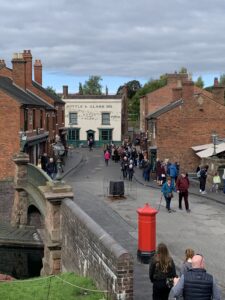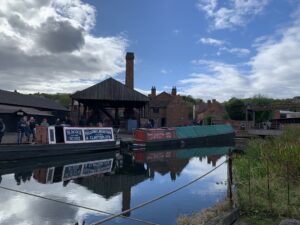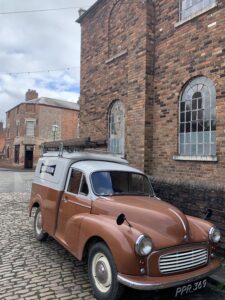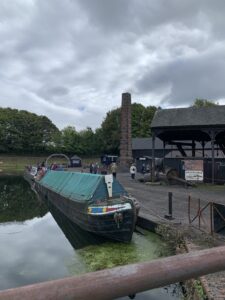Click here to go to the Black Country Living Museum website

On a rare dry albeit overcast day in September this year we decided to go on a day out to The Black Country Living Museum near Dudley. It’s somewhere that Jonathan remembers going to on a primary school trip but the rest of us (me and a teenage daughter) had never been. Similar to the concept of Blist Hill near Ironbridge, The Black Country Living Museum is an open-air museum with reconstructed shops, houses and industrial areas telling the story of The Black Country through the ages from the Industrial Revolution through to the 1960s.
For those unfamiliar with the term, The Black Country is an area of the West Midlands encompassing the towns of Dudley, Walsall and West Bromwich and named after the coal seam running beneath. It was heavily mined during the Industrial Revolution not only for coal but also limestone and was a major producer of iron and steel. During Victorian times it was one of the most industrialised areas of the country with a network of canals and railways criss-crossing the area.

The museum is about an hours drive from St Milburga Chapel, the first half of the journey passed through some beautiful scenery as we navigated the Shropshire Hills. There was a stunning view across the Severn Valley about 5 minutes after leaving the chapel. That alone made the journey worth it.
On arrival, we parked in the large carpark and a short walk took us to the modern visitor centre. We didn’t have to queue long for tickets (you can pre-book tickets online but there is no price difference and that queue wasn’t any shorter so probably only worth it during the holidays when it’s busier). Standard tickets are valid for 12 months and you can come back anytime so if you are going to make a return journey, we felt that they were good value.
We were advised at the ticket desk to make our way to the far end of the museum and work backwards which is very good advice as there is a lot to see across the site. We made our way downhill, crossing over the canal and found ourselves back in Victorian England. Heading for the canal basin first we found that this had been used as a set on Peaky Blinders as had the main streets. There are little blue plaques about the place telling you the exact scene and episode for any Peaky Blinders fans out there.

We had fun exploring the houses, outbuildings and passages dressed as they would have been in the Victorian era. As these are real buildings, that have been deconstructed from various parts of The Black Country and then reconstructed brick for brick at the museum, they can also tell you the history of their inhabitants. It is eye-opening to find out how many people were crammed into some of the poorest looking houses on the site.
We very much enjoyed exploring the shops including the general stores, pharmacist and hardware stores. There are also a couple of fish and chips shops in this part of the museum and even though it wasn’t a particular busy day, huge queues snaked along the street once frying got underway and they were extremely popular. We decided to head for the marginally less busy café in The Workers Institute serving jacket potatoes, soup and sandwiches. I particularly liked how my tea came in an authentic, slightly battered looking enamel mug!
After lunch, we moved from the Victorian era and explored the part of the site with houses and shops from the 1930s through to the 1960s. We especially enjoyed the 1930s pre-fab houses constructed from sheets of iron! Myself and Jonathan also liked looking at the chocolate bars in the 1960s newsagents, many of which were familiar from our childhoods, and seeing just how much they had shrunk over the years.
This part of the site also has a fairground with rides from the 1930s onwards. You purchase tokens to go on the rides and attractions which we didn’t think were too badly priced compared to modern fairgrounds. We had great fun on the swings and had a laugh on the ghost train.
By this time, it was quite late in the afternoon. We had just enough time for a reviving hot drink in the café in the visitor centre and an obligatory nosy around the shop before heading home. We ran out of time to see everything in the first visit – we didn’t have time for the underground mine tour for instance – so will definitely be using our tickets again.

Would we recommend a trip out from St Milburga Chapel? Absolutely, if you love history or are a Peaky Blinders fan and fancy a full day out, we would definitely recommend. It’s a great place to come whatever your age. Younger generations will enjoy the playground, fairground and marvelling how people used to live while older generations will no doubt have a welcome trip down memory lane.
